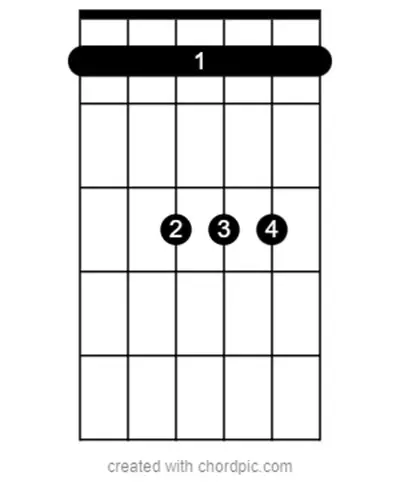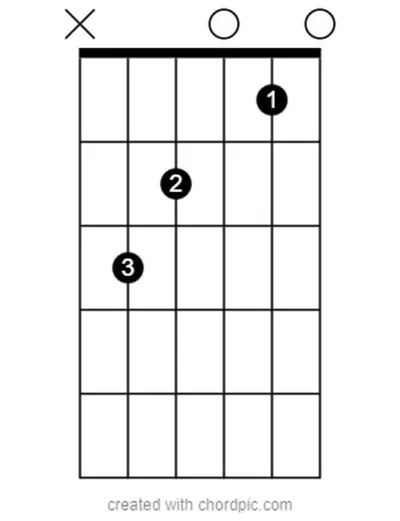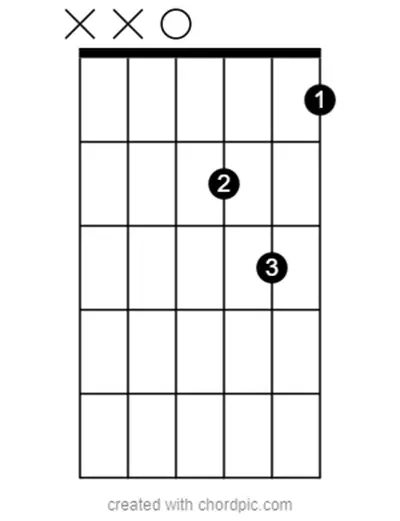Discovering what guitar chords are in F can be a transformative step in your musical journey. This article offers a comprehensive guide to mastering these chords, tailored to help even beginners grasp the basics effortlessly. Whether you’re just starting out or looking to refine your skills, understanding the F chord and its variations is crucial.

Understanding the Basics: What Guitar Chords Are in F?
Before we start exploring the specific chords, it’s crucial to grasp the concept behind the phrase “what guitar chords are in F.” When we talk about guitar chords in the context of a particular key – in this case, the key of F – we are referring to a group of chords that harmonically complement each other within that key.
Playing in a specific key means that you are focusing on a set of chords that sound pleasing together because they are all centered around a particular note, which in this case is F.
The key of F is known for its warm and rich tones and is a popular choice in various music genres, from classical to pop and rock. Understanding and playing chords in this key involves knowing not only the primary chord, F major, but also several other chords that harmonically align with it.
Each chord in the key of F has a unique position and finger arrangement on the guitar fretboard. This means that to play these chords correctly, you will need to learn where to place your fingers on the strings and frets.
For instance, some chords may require you to use a barre technique, where you use one finger to press down multiple strings across the fretboard.
Others might need a combination of fingers spread out across different frets and strings. It’s this variety in finger positions and arrangements that gives each chord its distinctive sound and character.
In the following sections, we’ll break down these chords one by one. Starting with the foundational F major chord, we’ll guide you through the finger placements and techniques required to play each chord effectively.
The F Major Chord

The F major chord is indeed the cornerstone of playing in the key of F. Mastering this chord is fundamental to your journey in guitar playing, especially in this key. Let’s break down the steps to play the F major chord more thoroughly:
Forming the Barre with Your Index Finger
Start by placing your index finger across all six strings at the first fret. This technique is known as forming a barre. It might feel a bit challenging at first, especially if you’re new to barre chords.
The key here is to apply even pressure across all the strings. Make sure that your finger is as straight as possible. This might require some wrist adjustment to ensure that the barre is firm and that all strings ring clearly when played.
Positioning the Middle Finger
Next, place your middle finger on the second fret of the G string, which is the third string from the bottom. This finger placement is crucial as it helps to define the major quality of the chord. Ensure that your middle finger is not touching any adjacent strings to allow them to ring freely.
Using the Ring and Pinky Fingers
Now, put your ring finger on the third fret of the A string (the fifth string), and your pinky finger right beside it on the third fret of the D string (the fourth string). These fingers give the chord its full, rich sound. It’s important to keep your fingers arched, so they don’t accidentally mute the other strings.
Strumming and Adjusting
Once your fingers are in place, strum all six strings. Listen to each string’s sound. If any of them sound muted or buzzy, adjust your fingers slightly.
This may involve pressing harder, repositioning your fingers, or ensuring that your barre is evenly pressing down all strings. Achieving a clear sound from a barre chord takes practice, so be patient and persistent.
Chord Progressions in the Key of F
Chord progressions are essential for creating music, as they are sequences of chords that sound harmonious when played in sequence. In the key of F, some common chord progressions include F – Bb – C – F or F – A – Dm – Bb. These progressions are frequently used in a variety of songs and styles.
To play these additional chords, you’ll follow similar steps of positioning your fingers on the fretboard to create each chord.
The Bb chord, for example, is another barre chord that will require you to use a technique similar to the one you used for the F major chord. The A and Dm chords, on the other hand, will involve different finger placements and may be easier to play for beginners.
As we move forward, we’ll break down each of these chords, providing you with step-by-step instructions on how to play them. Remember, learning guitar is a gradual process. Each new chord you learn and every progression you master brings you closer to becoming a proficient guitarist, especially in the rich and melodic key of F.
Bb Major Chord

The Bb major chord is another integral chord when playing in the key of F. It might seem a bit tricky at first, especially due to its barre formation, but with practice, you’ll find it becomes more comfortable. Let’s break down the steps:
Forming the Barre: Start by barring your index finger across all the strings on the first fret. Just like with the F major chord, this requires pressing down all the strings firmly. Ensure your finger is straight, and try to use the side of your finger for a more effective barre. This may require adjusting your wrist and thumb position for better leverage.
Placing the Middle Finger: Now, place your middle finger on the third fret of the D string (fourth string). This placement is critical for the chord’s structure. Make sure that this finger does not touch any other strings.
Using Ring and Pinky Fingers: Position your ring finger on the third fret of the G string (third string), and your pinky finger on the third fret of the B string (second string). These two fingers complete the chord. It’s important to keep the fingers arched and not let them flatten, which could mute adjacent strings.
C Major Chord

The C major chord is a more straightforward chord to play, and it’s a staple in many songs. Here’s how to play it:
Ring Finger Placement: Begin by placing your ring finger on the third fret of the A string (fifth string). This finger should press down firmly to produce a clear note. Ensure it’s not touching any other strings.
Middle Finger on the D String: Next, put your middle finger on the second fret of the D string (fourth string). As with the ring finger, ensure it is only pressing on the intended string and not accidentally muting others.
Index Finger on the B String: Lastly, place your index finger on the first fret of the B string (second string). This finger placement gives the chord its distinctive major quality. Be sure to press down enough to produce a clear sound.
Read more on guitars here – Common Guitar Questions: Guide to “What” Guitar Questions
A Major Chord

The A Major chord is a fundamental chord in guitar playing, known for its bright and open sound. Playing it involves using three fingers on the same fret, which might seem a bit cramped at first, but with practice, it becomes more manageable. Here’s how to do it:
Finger Placement: Begin by placing your index finger on the second fret of the D string (fourth string), your middle finger on the second fret of the G string (third string), and your ring finger on the second fret of the B string (second string).
Positioning Your Fingers: Try to keep your fingers as close to the fret as possible without being on top of it. This positioning helps in producing a clearer sound. It’s a tight space, so you might need to angle your fingers slightly to fit them all in.
Strumming the Chord: Strum from the A string (fifth string) downwards. The E string (sixth string) is not typically played in this chord. Ensure that each string is ringing clearly. If you hear any muted or buzzing sounds, adjust your fingers slightly, making sure they’re not touching adjacent strings.
Dm (D Minor) Chord

The D minor chord has a somber and melancholic sound. It’s a key chord in many songs and is essential for your chord repertoire. Here’s how to play it:
High E String: Start by placing your index finger on the first fret of the high E string (first string). Make sure your finger is close to the fret, but not on top of it, for a clearer sound.
G String Placement: Put your middle finger on the second fret of the G string (third string). Ensure that this finger is not accidentally touching other strings, which could mute them.
B String Positioning: Finally, place your ring finger on the third fret of the B string (second string). This finger gives the chord its minor quality.
Strumming the Dm Chord: When strumming the Dm chord, you usually start from the D string (fourth string) and strum downwards. The A and E strings (fifth and sixth strings) are typically not included in this chord.
Practice Tips
Embarking on the journey of learning guitar chords in the key of F, or any new set of skills on the guitar, requires dedication and patience.
It’s normal to encounter challenges along the way, especially with complex chords like barre chords. Here are some detailed practice tips and troubleshooting strategies to help you overcome these hurdles:
Start Slowly: Begin by practicing each chord individually. Focus on placing your fingers in the correct positions and strumming each string to ensure they all ring clearly. It’s more important to play slowly and accurately than quickly and sloppily.
Transition Practice: Once you’re comfortable playing individual chords, practice transitioning between them. Start with moving between two chords back and forth. Do this slowly, ensuring each chord sounds clear before speeding up.
Hand Position and Finger Pressure: If a chord doesn’t sound right, look at your hand position. Are your fingers arched enough to avoid muting adjacent strings? Are you pressing hard enough to make each string ring clearly, but not so hard that it causes discomfort? Small adjustments can make a big difference.
Building Strength and Flexibility: Barre chords, like the F major, can be particularly challenging because they require more finger strength and flexibility. Start by practicing the barre position itself, without worrying about the other fingers. Gradually add in the other fingers as you build strength.
Regular Practice: Consistency is key. Regular practice, even if it’s just for a few minutes a day, can lead to significant improvements over time. Your fingers will develop muscle memory, making it easier to form chords and transition between them.
Taking Breaks: If you feel any pain or excessive fatigue, take a break. It’s important to listen to your body to avoid strain or injury.
Seeking Feedback: If possible, get feedback from a more experienced guitarist or a teacher. They can provide valuable insights and tips tailored to your specific challenges.
Remember, every guitarist, no matter how skilled, started as a beginner and faced their own challenges. The key is persistence and patience with yourself. With time and practice, what feels challenging today will become second nature.
Conclusion: What Guitar Chords Are in F?
Mastering the chords in the key of F is a rewarding journey. These chords form the foundation of many songs and will enhance your overall guitar playing skills. Keep practicing, and soon, you’ll play these chords with confidence and ease.